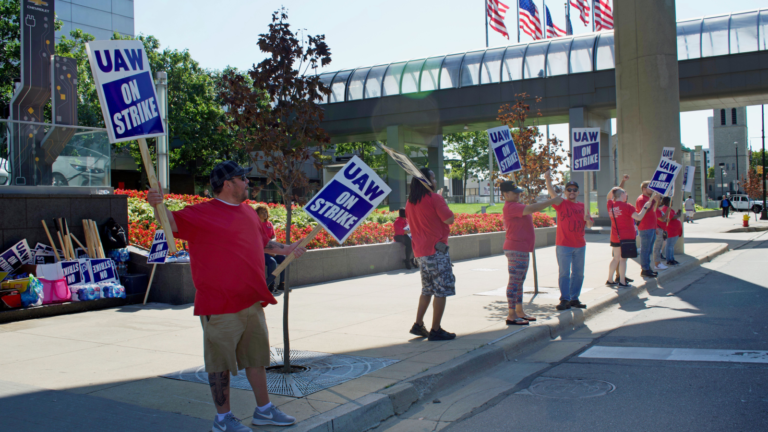The United States is experiencing a significant surge in labor strikes, involving various unions and industries. The result of these strikes is a cumulative 4.1 million lost workdays last month, the highest in over two decades.
United Auto Workers (UAW) members initiated strikes at major auto plants owned by Ford (NYSE:F), General Motors (NYSE:GM) and Stellantis (NYSE:STLA), creating industry uncertainty as they seek improved wages and conditions for their members. This tactic, involving selective strikes across all three automakers, is a novel approach for the union.
Economist Patrick Anderson warns that this strategy may backfire, potentially causing more plant closures than intended as it disrupts the industry’s operations. The impact of a protracted strike extends beyond the workers, despite the $500 weekly strike pay provided by UAW.
While it could be bad headlines and news for the automakers, there are some potential benefits to consumers. Let’s dive into what this means for consumers in these three stocks.
What Happened
The initial UAW strike hit plants in Missouri, Ohio and Michigan, challenging Ford, GM and Stellantis. Union President Shawn Fain emphasized the aim of achieving “economic justice.” The UAW seeks a 40% pay increase (commensurate with increases at the executive level of the company), while automakers offer about half. They also want a four-day workweek and pension reinstatement, proposals not yet accepted by the companies.
Fain revealed plans to expand the strike to 38 new sites across the nation, targeting General Motors and Stellantis. While progress was made with Ford, Fain emphasized the need to push GM and Stellantis for better terms. The strike will include parts distribution centers from California to Massachusetts, with further expansion if necessary.
Workers at 38 locations across nine states for both GM and Stellantis are set to strike, according to Fain. The UAW continues negotiations with Ford but isn’t expanding the strike there. Negotiations with the three automakers have been ongoing, with offers exchanged but no tentative agreement reached.
Fain initiated the strike against the Detroit Three automakers a week ago due to contract negotiation failures. The first wave of strikes targeted specific plants, including Ford’s Michigan Assembly Plant (Final Assembly and Paint), Stellantis’s Toledo Assembly Complex, and GM’s Wentzville Assembly.
Why Consumers Shouldn’t Worry Yet
Purchasing a car was already costly, with record-high new vehicle prices and significantly increased financing interest rates. Currently, car buyers won’t feel an immediate impact from the strike due to sufficient dealer inventory. Vehicle supply has nearly stabilized heading into the fall, albeit still below historical levels.
In August, the automakers increased their inventories by about 80%, providing a 50- to 60-day supply. This may mitigate immediate impacts on dealers, according to Lotlinx, a dealership inventory management firm.
On the positive side, the UAW strike could lead to lower interest rates and cheaper loans for consumers who want to buy a new car or refinance their existing one. This is because the Federal Reserve may cut rates to stimulate the economy and offset the losses from the auto industry. Consumers could also benefit from lower gas prices as the demand for fuel decreases due to fewer cars on the road.
Experts suggest budget-conscious buyers might find better deals in the used car market, but research indicates that wholesale used vehicle prices may have hit their lowest point for the year. “As new car production slows, used car values are likely to rise,” according to Ivan Drury, Edmunds director of insights.
What Now
Concerns about labor activism’s impact on the U.S. economy are unfounded. Labor activism benefits the economy in the long term. It’s not a special interest but represents the American workforce. This surge in labor activity isn’t because workers enjoy striking; it’s driven by the need for fair wages and conditions.
Strike funds only partially compensate for lost wages, and corporations may lay off other workers in response to strikes.
Today’s media focus on the potential negative impacts of the current strike wave on the U.S. economy but overlook the historical role of strikes in building the American middle class and postwar prosperity. Stagnant wages and inequality fuel anger and can be exploited by demagogic politicians.
The current strike wave may not have to be detrimental to consumers. Investors may take a hit, but car buyers have been taking most of the hits in recent years. Maybe such a shift is a good thing for the average Joe.
On the date of publication, Chris MacDonald did not have (either directly or indirectly) any positions in the securities mentioned in this article. The opinions expressed in this article are those of the writer, subject to the InvestorPlace.com Publishing Guidelines.

